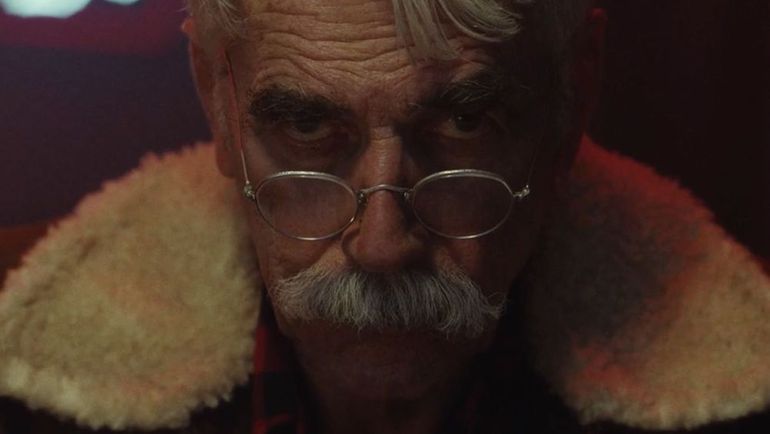The Man Who Killed Hitler and Then The Bigfoot (2018)

It Stares Back
Usually when I'm not "feeling" a movie, it's difficult to point to any one particular thing and say, "That's it! That's why none of this works!" Thankfully, The Man Who Killed Hitler and Then The Bigfoot provided a giant, hairy signpost for my malaise. Toward the end of the film, as Sam Elliott wrestles with Bigfoot (sorry, "The" Bigfoot), the creature vomits thick, pink-orange sputum into Elliott's mouth. It's not just a grindhouse-trailer moment, it's a Grindhouse trailer moment, an All Caps encapsulation of what makes our collective obsession with '70s exploitation appropriation so powerful: Cult Character Actor + Kitschy, Low-Budget Premise x Over the Top Gore = Nostalgia Bomb3.
Had the rest of the movie embraced the promise of the premise (or even the era-authentic title card, complete with production date in Roman numerals), I might have been on board in the same way I rooted for Quentin Tarantino's Death Proof, Todd Strauss-Schulson's The Final Girls, or, to a lesser extent, Robert Rodriguez's Planet Terror. But just about everything writer/director Robert D. Krzykowski has to offer is in the title, and in the handful of sporadic trailer-worthy moments that he scatters throughout his wildly incongruous film. This is not a midnight movie; it's Walden Pond with commercial interruptions.
I'm about to get into specifics here, so turn back now if you don't want to know precisely why this project was doomed very early on in the creative process.
Still with me? Good. Let's dive in.
The film opens with World War II veteran Calvin Barr (Elliott) remembering his time as an elite spy for the U.S. Army. In flashback, we see a twenty-something version of him (Aidan Turner) posing as an SS officer and working his way through a series of checkpoints and pat-downs before gaining access to Adolf Hitler's office.* The resolution of their encounter (and the whole Bigfoot subplot, better described as an "afterplot") isn't revealed until much later. Besides a geriatric, Jack Reacher-lite parking lot fight with some townies, much of the story hinges on Barr moping about his house and the sleepy streets of his small town, wandering in and out of existential crises and a broken heart. He was in love with a school teacher named Maxine (Caitlin Fitzgerald) before the War, you see, and The Man Who's great mystery is "Whatever Happened to the Girl Who Got Away?"
We're still left with this question at the end. I mean, she's dead. That much is handed to us in a bit of offhand dialogue that comes far too late to be helpful. But even the basic facts of Maxine's relationship with Calvin are cast aside in favor of time-jumping theatrics and morose reflection on a tragedy that doesn't really add up. How long were they together before Calvin's service? How long was Calvin away? How much time passed between Maxine's last letter to Calvin and her move to another state to live near her parents? And why, upon reading this news, didn't Calvin immediately hop on a train to win back the love of his life? Was she dead by then? If so, why didn't anyone tell Calvin when he arrived back home? More importantly, why didn't anyone bother to tell us?
These are warm-ups to The Man Who's larger conundrums, which center on the identity of Calvin Barr. He speaks multiple languages; has keen negotiating skills with Russian mystics;** and can so thoroughly James Bond his way into enemy territory that he barely breaks a sweat while assembling his anti-Hitler gun out of a flask and fashion accessories during the long wall down a heavily guarded hallway. It's entirely possible that I missed the twenty-minute exposition scene wherein we learn that Calvin is a patriotic prodigy, or the beneficiary of a Super Soldier Serum--but I don't think so. To hear this small-town hat salesman tell it, he simply "did what he was told".
Okaaaaay.
There's an even bigger problem at hand, if you can believe it. Calvin is a pacifist, or at least he abhors the idea of killing. We learn that he spent all his post-war decades crying over Maxine and drowning in regret that he murdered someone. To reiterate, that "someone" was Adolf Hitler.
This is where a training montage would have been helpful. In this instance, I don't really care about watching Calvin do fifty sit-ups in a minute or recite the Russian alphabet in as much time. No, I just want to be a fly on the wall of the Army brass as they review his record, aptitude, and psychological profile. I'm neither a military expert nor a historian, but I have a hard time accepting that Uncle Sam would entrust a pacifist with assassinating Adolf Hitler--regardless of whether or not (according to Calvin in later years) der Führer's ideas were more significant than his actual personage in 1945. The modern analogue is the raid on Osama Bin Laden's compound, and I suspect there's a reason we sent Navy Seals to do the job, instead of Coast Guard Reservists.
Let's compound this problem, as the movie does, by looking at The Man Who's strongest scene: two federal agents, nicknamed Flag Pin (Ron Livingston) and Maple Leaf (Rizwan Manji), visit the elderly Calvin Barr with a mission. The Bigfoot has been spotted in the wilds of Canada, and not only is it killing tourists, it's harboring a super-virus guaranteed to wipeout humanity if not contained. In an effort to warm icy tensions between the three, Flag Pin tells Calvin about the amazing yarns his grandfather used to spin about a military legend who did incredible, Top Secret things, including killing Hitler.
So now we're asked to believe that Calvin Barr--weepy, guilt-stricken pacifist Calvin Barr--was also Captain America and Indiana Jones wrapped into one. And he did all his globe-trotting adventuring without...killing anyone. Did his double-super-secret exploits involvee slapping Nazis and Communists into submission? Did he bravely sterilize the operating room during the Roswell incident? Maybe he drove Oliver North to the Iran Contra hearings?
As a character, Calvin Barr doesn't make any sense. And perhaps he's not meant to. It would take less effort than you might think to set up the fundamentals before launching into this short-sighted tall tale. Just look at Mel Gibson's much-maligned but narratively note-perfect Hacksaw Ridge. As broadly drawn as that love story was, the audience at least had a foundation for who Andrew Garfield's character (also a pacifist) was and what he was risking by heading off to war, both spiritually and relationally.
Robert Krzykowski's screenplay (and, subsequently, his film's final edit) falls into the same trap as a lot of the mid-to-late-'90s Pulp Fiction knock-offs. I don't have any insight as to how Krzykowski laid out his script, but the result feels as if he jumped in with a loose, time-jumping structure in place, rather than planning out a straightforward series of themes and "A" and "B" plots, and then re-arranging them chronologically in such a way that preserved their core integrity. Based on the end result, it looks like all the critical information that makes stories make sense was sacrificed to the cutting room in the name of expediency and "cool".
You can see evidence (circumstantial as it may be) in the Third Act, when we finally get into the Bigfoot stuff. In the course of two minutes, Calvin transitions from talking to his brother about accepting the assignment; sitting in a quarantine facility near Canada where he chooses his weapons; standing outside an impossible wall of nighttime fire in the Great White North, and then ducking behind a tree after having taken a shot at The Bigfoot sometime the next day (or the day after that. Hell, it could've been a week).
Again, I had to wonder if there weren't several scenes missing. In the last fifteen minutes, The Man Who devolves from confused movie to awkward highlight reel, which brought me back to Grindhouse. You may wonder what kind of humorless scold would spend several hours and fourteen-hundred-plus words nitpicking a movie called The Man Who Killed Hitler and Then The Bigfoot.
I take movies seriously, even the silly ones. Especially the silly ones. If a darkly comic genius or a big-hearted, off-kilter dramatist can do the heavy lifting of locking down character, plot, motif, and structure for me, that lessens my brain's obligation to apply real-world logic to a fantasy. I don't appreciate having to confront escapism, but I'll do it--every time.
*In The Man Who's version of history, that nutcase in the bunker was one of several body doubles.
**I'm sure there's a back-slapping metaphor that ties together the fact that A) this mystic reads the future by shaving spies' faces, and B) Calvin's little brother, Ed (Larry Miller), is the town barber and the personification of Calvin's regret--but I'll be damned if I can muster up the energy to dig for it.




